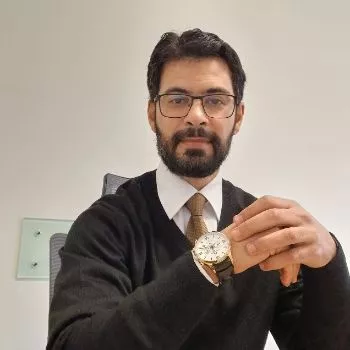محمد جمعة محمد جبيل
رئيس قسم الجراحة
عضو هيئة تدريس قار
المؤهل العلمي: دكتوراه
الدرجة العلمية: محاضر
التخصص: جراحة اطفال - جراحة
قسم الجراحة - كلية الطب البشري - الزنتان
حول محمد
د. محمد جبيل متحصل على درجة الدكتوراة في جراحة الاطفال و حديثي الولادة و خريج كلية الطب طرابلس، يعمل كمستشار جراحة أطفال و رئيس لقسم الجراحة و فروعها بكلية الطب جامعة الزنتان عمل سابقا بمستشفى طرابلس الجامعي و شغل بالتكليف رئاسة قسم جراحة الأطفال، و عمل كمحاضر سابق بمجلس التخصصات الطبي، نشرت له بعض الأبحاث في مجلات دولية محكمة.
المنشورات العلمية
Epidemiology of Hypospadias in Libya Incidence, Risk Factors, and Treatment Challenges
Technical ReportHypospadias is a common congenital anomaly that affects the male genitalia. This research paper aims to investigate the incidence of hypospadias in Libya by analyzing existing literature, statistical data, and medical records.
The study will explore the prevalence of hypospadias among newborn boys in various regions of Libya, as well as the factors that may contribute to the development of this condition.
Additionally, the paper will discuss the current treatment options available for hypospadias patients in Libya and the challenges faced by healthcare providers in managing this condition. By providing a comprehensive overview of hypospadias incidence in Libya, this research paper will contribute to the understanding and improvement of care for individuals with this congenital anomaly.
Mohamed Juma Mohamed Jubail, (05-2024), manuscript: جامعة الزنتان,
Outcomes after surgery for children in Africa (ASOS-Paeds): a 14-day prospective observational cohort study
Journal ArticleBackground
Safe anaesthesia and surgery are a public health imperative. There are few data describing outcomes for children undergoing anesthesia and surgery in Africa. We aimed to get robust epidemiological data to describe patient care and outcomes for children undergoing anesthesia and surgery in hospitals in Africa.
Methods
This study was a 14-day, international, prospective, observational cohort study of children (aged <18 years) undergoing surgery in Africa. We recruited as many hospitals as possible across all levels of care (first, second, and third) providing surgical treatment. Each hospital recruited all eligible children for a 14-day period commencing on the date chosen by each participating hospital within the study recruitment period from Jan 15 to Dec 23, 2022. Data were collected prospectively for consecutive patients on paper case record forms. The primary outcome was in-hospital postoperative complications within 30 days of surgery and the secondary outcome was in-hospital mortality within 30 days after surgery. We also collected hospital-level data describing equipment, facilities, and protocols available. This study is registered with ClinicalTrials.gov, NCT05061407.
Findings
We recruited 8625 children from 249 hospitals in 31 African countries. The mean age was 6·1 (SD 4·9) years, with 5675 (66·0%) of 8600 children being male. Most children (6110 [71·2%] of 8579 patients) were from category 1 of the American Society of Anesthesiologists Physical Status score undergoing elective surgery (5325 [61·9%] of 8604 patients). Postoperative complications occurred in 1532 (18·0%) of 8515 children, predominated by infections (971 [11·4%] of 8538 children). Deaths occurred in 199 (2·3%) of 8596 patients, 169 (84·9%) of 199 patients following emergency surgeries. Deaths following postoperative complications occurred in 166 (10·8%) of 1530 complications. Operating rooms were reported as safe for anaesthesia and surgery for neonates (121 [54·3%] of 223 hospitals), infants (147 [65·9%] of 223 hospitals), and children younger than 6 years (188 [84·3%] of 223 hospitals).
Mohamed Juma Mohamed Jubail, (03-2024), The Lancet journal: Elsevier Ltd, 403
Abdominal Wall Defects: Current Practices and Outcomes in the Developing World: Tripoli Medical Center as a Model
Journal ArticleAbstract Introduction: Abdominal wall defects (AWD) are a common problem that can become difficult to manage, especially when the defect is large and resources are limited (silo and TPN). Methods: Retrospectively, 85 medical records of patients who have been admitted to TMC over a decade (2005 - 2015) were studied. The defects have been categorized into three groups: omphalocele minor, omphalocele major and gastroschisis. The aim is compare the outcomes within these three groups between developed and developing nations. Results: Out of 85 neonates with abdominal wall defects, 50 are males and 35 are females. 58 patients had omphalocele minor, 16 omphalocele major and 11 with gastroschisis. Associated congenital anomalies are reported in 45% of omphalocele groups (1 and 2) and in 27% of gastroschisis group. Post-operative morbidity rate among the omphalocele groups (1 and 2) is 27.37%, and 54.54% among gastroschisis group. Mortality rate among the group one is 3.45%, group two 12.5%, and group three 27.27%. The mortality rate among the two patients who received devices was 50%. Conclusion: Omphalocele can be treated effectively in the developing world; however, gastroschisis cases need more sophisticated supportive measures to reach the reported rates.
Mohamed Juma Mohamed Jubail, (02-2020), EC Pediatrics Journal: ECronicon Journal, 9

